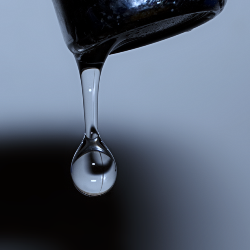On the nanoscale there is another world that we barely glimpse. How can we build things in it?
In everyday life we can handle objects and glue them together. However on the nanoscale this is hard. As nanodevices are small, we often need a lot of them (billions) to accomplish a task. Even when we can handle objects with enough precision it is not sensible to build nanodevices one by one. We need to design ways for them to build themselves.

Making microdroplets by the “dripping tap” method. Water droplets are pinched off in a flow of oil.
Making microdroplets by the “dripping tap” method. Water droplets are pinched off in a flow of oil.Microfluidic droplets have emerged as an important way to make and assemble nanostructures. Microdroplets are 50 million times smaller than ordinary drops. That is small enough for them to each hold a few nanoparticles, but even on this tiny scale it is still a challenge to grasp nanoparticles. If the droplets were a mile wide the nanoparticles would be about the size of a beach ball. Precise control is therefore needed and this is only possible because microdroplets can be made in large amounts and all exactly the same size by scaling down the principle behind a dripping tap.

Precise gold nanoparticle assembly using cucurbit[n]uril.
Precise gold nanoparticle assembly using cucurbit[n]uril.Having packaged the nano-components the next step is to put them together in a controlled way. But what about the assembly do we want to control? My research focusses on gold nanoparticles. These are fascinating because they manipulate light on the nanoscale. The electric field of light bounces the the electrons in the gold back and forth. Those electrons then generate their own electric field in a way that effectively focuses the light. This can be used to detect substances (drugs, pollutants, explosives) at low concentrations. If the structure is made just right even individual molecules can be detected.
For this application the crucial parameters are the spacing between nanoparticle units and where the molecules are placed. The nanoparticles need to be extremely close, but not touching, and the molecules need to sit in the gap in between. The overall structure (chains, branches…) is not so important.
We control these aspects of the nanoassembly using cucurbit[n]uril. This molecule glues the nanoparticles together which at the same time defines the particle spacing to be one cucurbit[n]uril-width wide. In addition, cucurbit[n]uril has a cavity that can capture the molecule to be sensed. As the cucurbit[n]uril defines the gap this puts the trapped molecule in exactly the right place to be detected. Therefore all the important aspects of the assembly are elegantly controlled.
However, some core questions are yet to be answered and this is the focus of my work. How does the sensing behave during the nanoparticle assembly? Is there an ideal assembly size? What makes the cucurbit[n]uril glue sticky? Can we sense real analytes, e.g. biomaterials produced by microalgae?

